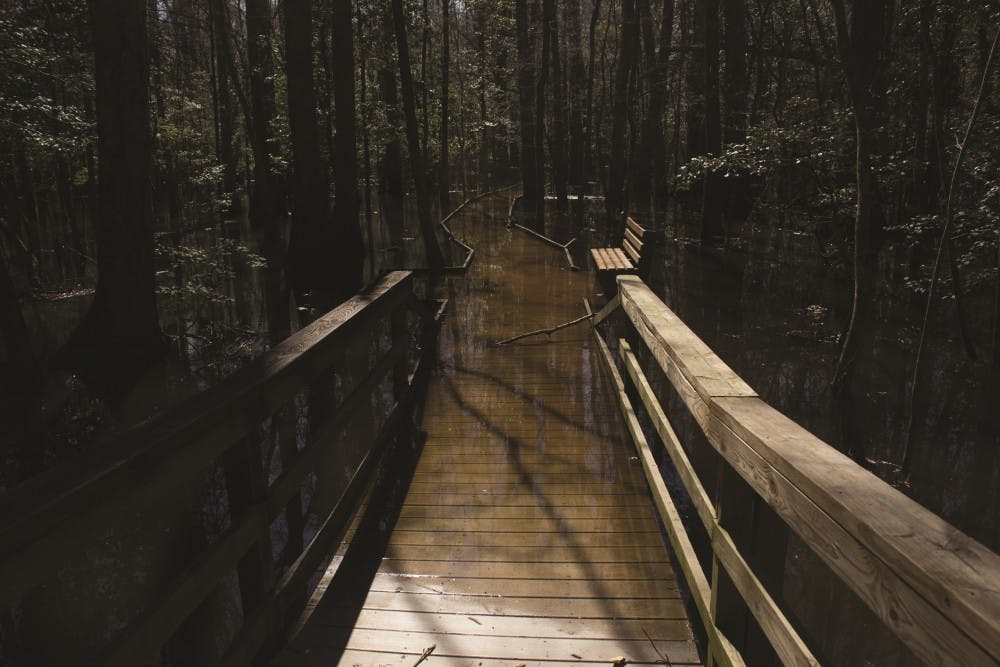Photo by Alyssa-Leigh Willey
A U.S. national park. A UNESCO biosphere reserve. A site for an annual synchronous firefly light show. These signifiers of environmental and cultural importance describe Congaree National Park, South Carolina’s only national park that happens to be a mere 30-minute drive from the University of South Carolina’s campus.
Although Congaree National Park celebrated its 15th anniversary last year, the park is still relatively new and receives far less traffic than well-known national treasures like Yellowstone or the Great Smoky Mountains. In fact, out of all 59 designated national parks, Congaree falls within the top ten least-visited parks despite having the largest surrounding population of all other parks on the list. While one could debate why the park is one of the least visited, it’s not hard to understand why attendance at the park has been growing to well over 150,000 visitors each year.
The park offers what one would expect for any large park and then exceeds those expectations by placing each visitor into the beauty of an ancient floodplain: towering cypresses and green foliage that put the set of "Jurassic Park" to shame. From kayaking and canoeing on the placid Congaree River to trekking on the 25 miles of trails, the park gives visitors easy access to South Carolina’s flora and fauna that the concrete of campus usually doesn’t allow. While attendance numbers might underrepresent the significance of the park, its recognition by the United Nations does not. The park’s unique, swampy environment, old growth trees and immense biodiversity set it apart from other spaces as a place worth conserving as a natural sanctuary. In one trip alone, a visitor might encounter a wild boar, a water moccasin, and if they are lucky – or perhaps, unlucky – an alligator.
If the year-round opportunity for fresh air isn’t enough, the park is home to another distinct and stunning natural phenomenon: synchronous fireflies. While the mystique of fireflies appearing on summer nights is well-known to those in South Carolina and around the United States, Congaree’s synchronous fireflies are an apparition that one has to see to believe. Every May, the fireflies make their appearance in the park, as well as the hordes of spectators who park their cars nearly a quarter of a mile away from the usual lots to gain entrance to the show. It is never clear when the fireflies will appear – exactly when in May or exactly what time of night the first ones will start to flicker their lights.
As crowds gather at nightfall, the park is pitch-black in its isolation from street and city lights, and the anticipation starts to build as the crowd wonders when exactly the blinking will begin. Eventually, a few flickers give way to hundreds as the flies blink their lights in unison, hovering a few feet above the ground on the edge of trails. The experience is akin to a Christmas light display but with a lot more mosquitoes. If the flies’ flickers didn’t waver in the air, it would appear as if Congaree had conspired to annually trick visitors by stringing lights around the park. Needless to say, the almost mythical feel of the park is only amplified by the fairy light show that the fireflies put on every May.
While Congaree may fly under the radar nationally, the existence of the almost 27,000 acres of land set aside for everyone’s appreciation verifies the significance of the greater Columbia area’s landscape. Beyond the daunting presence of mosquitoes in the warmer months – it is a swamp, after all – the park is a welcome sanctuary close to campus. Visitors to the park can expect the opportunity to embrace a protected piece of South Carolina, and, if visiting on an evening in May, to view how even fireflies use the sacred space to sync with each other and the environment around them.


